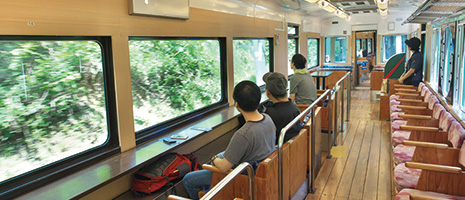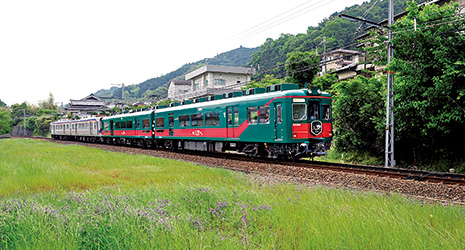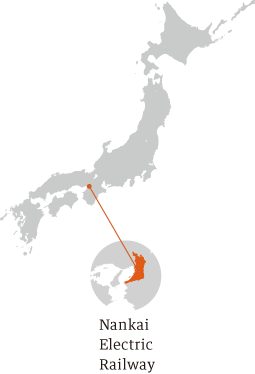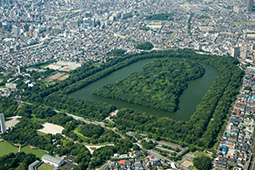Home > Highlighting JAPAN > Highlighting Japan September 2019 > A Trip by Local Train
Highlighting JAPAN


- PREVIOUS
- NEXT
A Journey Connecting the Bustling City of Osaka to World Heritage Sites
The Nankai Electric Railway’s Koya Line runs between the prefectures of Osaka and Wakayama. By taking a ride on the line, passengers can enjoy and appreciate Japan’s diverse culture and history from the ancient to the modern; from neon-lit downtown shopping districts to uniquely shaped ancient burial mounds, and sacred places in Japanese Buddhism, surrounded by greenery.
The Nankai Electric Railway Co., Ltd. (Nankai Electric Railway) was established in 1885, primarily through the efforts of leading Osaka businessmen. It has the longest history of any extant private railway company, and operates lines branching out from its base of operations at Namba Station in Chuo Ward, Osaka to destinations such as Kansai International Airport, Wakayama City and the town of Koya (also in Wakayama Prefecture). The Koya Line runs a distance of 64.4 km, connecting Namba Station to Koyasan Station in the town of Koya.
“The appeal of the Koya Line is that passengers can enjoy the changing scenery as they travel from Namba Station, in the center of Osaka, to Koyasan deep in the mountains. There are also many sights to see, including two World Heritage Sites along the route,” explains Kaoru Fujimoto of Nankai Electric Railway’s Transportation Department.
Namba Station is situated in an area of Osaka called Minami. Minami is one of Osaka’s representative downtown districts, packed with restaurants where visitors can enjoy Osaka food culture by eating dishes such as takoyaki (octopus balls) and okonomiyaki (savory pancake); and theaters where they can watch performance arts such as manzai (stand-up comedy) and kabuki. The Namba Station terminal building—the Nankai Building—was completed in 1932, and is one of a handful of buildings that symbolizes the Minami district. With its large Corinthian pillars and its terracotta-covered exterior, the building exudes an air of dignified elegance, and has been registered as a national registered tangible cultural property.
After boarding a train at Namba Station and traveling for around 15 minutes, passing by office buildings and residential areas, passengers arrive at Mikunigaoka Station in the city of Sakai, Osaka Prefecture. To the west side of the station lies the Nintoku-tenno-ryo Kofun, one of Japan’s largest kofun (burial mounds) and one of the heritage sites that makes up the Mozu-Furuichi Kofun Group (Mounded Tombs of Ancient Japan), which was added to UNESCO’s World Heritage List in July 2019.
The Nintoku-tenno-ryo Kofun (Tomb of Emperor Nintoku) is shaped like a keyhole, consisting of adjoined square and circular segments. The mound is covered by trees and encircled by three moats. Aside from the Tomb of Emperor Nintoku in Sakai, numerous other kofun—built between the latter half of the fourth century and the latter half of the fifth century—also remain in the neighboring cities of Habikino and Fujiidera. These mounds are all part of the Mozu-Furuichi Kofun Group, which consists of forty-nine distinct kofun in all.
After traveling for approximately 50 minutes from Namba Station, the train reaches Hashimoto Station in the city of Hashimoto, Wakayama. From here, the 19.8-km stretch to Gokuraubashi Station—in the foothills of Mount Koya—follows a steep gradient, passing through a total of twenty-four tunnels. The sightseeing train Tenku makes the return trip along this section two or three times a day, with four cars (two with reserved seating, and two with non-reserved seating). Tenku’s livery is designed with the image of the forest in mind, with a base color of dark green; and vermilion lines representing Mount Koya’s distinctively colored Konpon Daito pagoda. The seats, floor and other interior parts of the train cars are made from wood, and the designs of the window blinds and seat upholstery use a motif that features the moriaogaeru (forest green tree frog), which lives in the forests of Mount Koya.
“Tenku’s windows are intentionally larger than on regular trains, and many of the seats are positioned facing towards the windows, to enable passengers to fully enjoy the the greenery of the Mount Koya foothills during their journey. We have also provided observation decks, where we hope that passengers will appreciate the fresh mountain air,” says Fujimoto.
After a leisurely 40-minute ride through the mountains from Hashimoto Station, the train arrives at Gokurakubashi Station, at an altitude of 535 m. From here, passengers disembark from the train and transfer to a cable car. The new cable car was introduced in March 2019. After around five minutes climbing a steep, almost wall-like slope, the car reaches Koyasan Station—the final stop on the Koya Line—at a height of 867 m. The Koyasan Station building is a two-story wooden structure, built in 1928, and has been designated as a national registered tangible cultural property. On the second floor of the building there is a corner presenting historical and sightseeing information on the Koya Line, and an observation room from which visitors can survey the whole of Hashimoto City.
By taking a 15-minute bus ride from Koyasan Station, visitors can enter Mount Koya, which was registered as a World Heritage site in 2004 as part of the Sacred Sites and Pilgrimage Routes in the Kii Mountain Range. Mount Koya (or “Koyasan” in Japanese) is a significant sacred place in Japanese Buddhism, opened up around 1,200 years ago by the Buddhist monk Kukai (also known as Kobo Daishi, “The Grand Master Who Propagated the Buddhist Teaching”). Mount Koya has many Buddhist temples, including Kongobuji, and is visited by many worshippers and tourists throughout the year.
Riding the Koya Line enables passengers to savor both the hustle and bustle of the big city and the peaceful serenity of sacred places, and to learn about the culture and history of Japan, from the ancient all the way up to modern times.
- PREVIOUS
- NEXT
© 2009 Cabinet Office, Government of Japan








